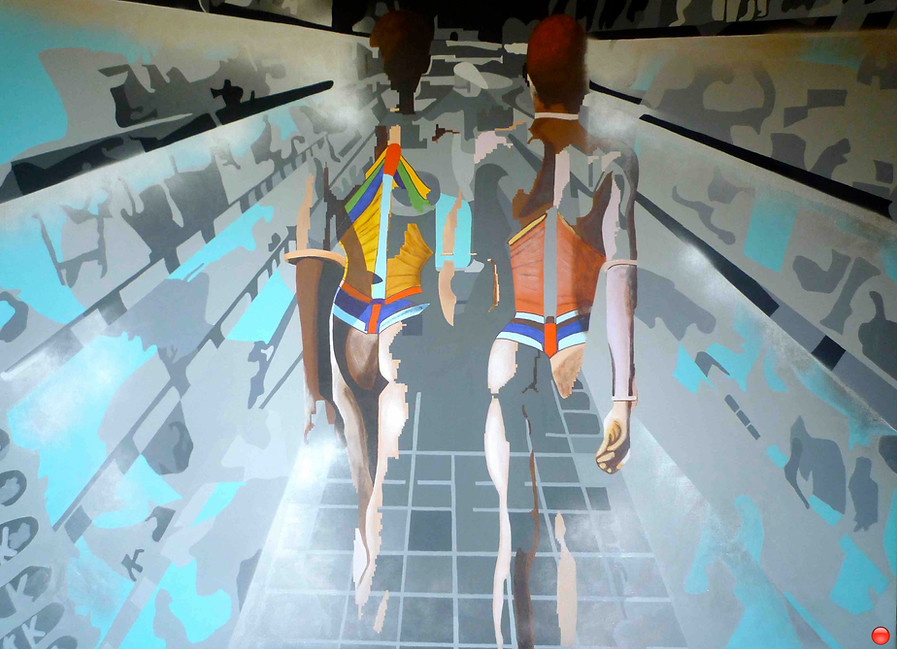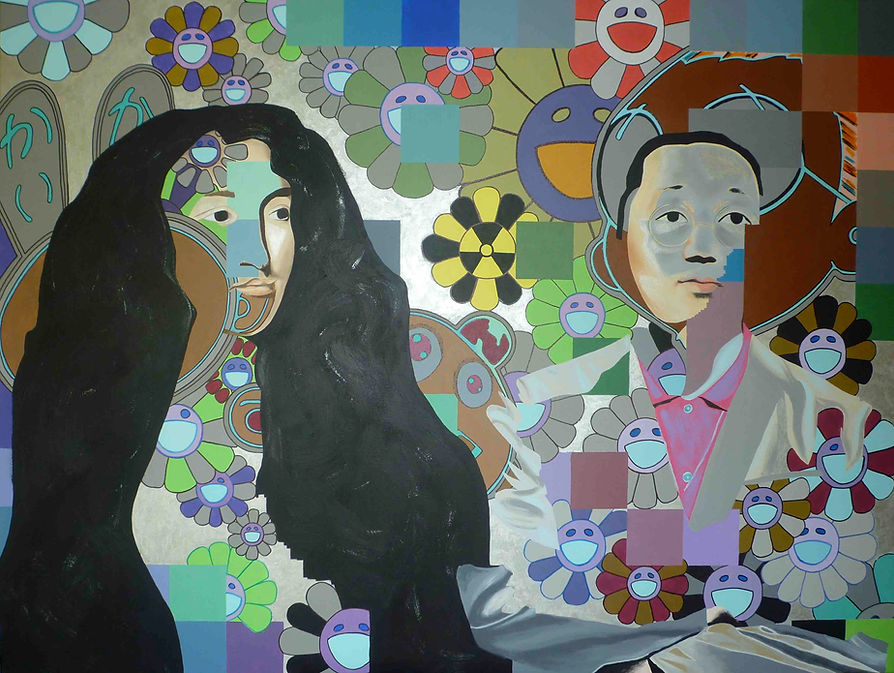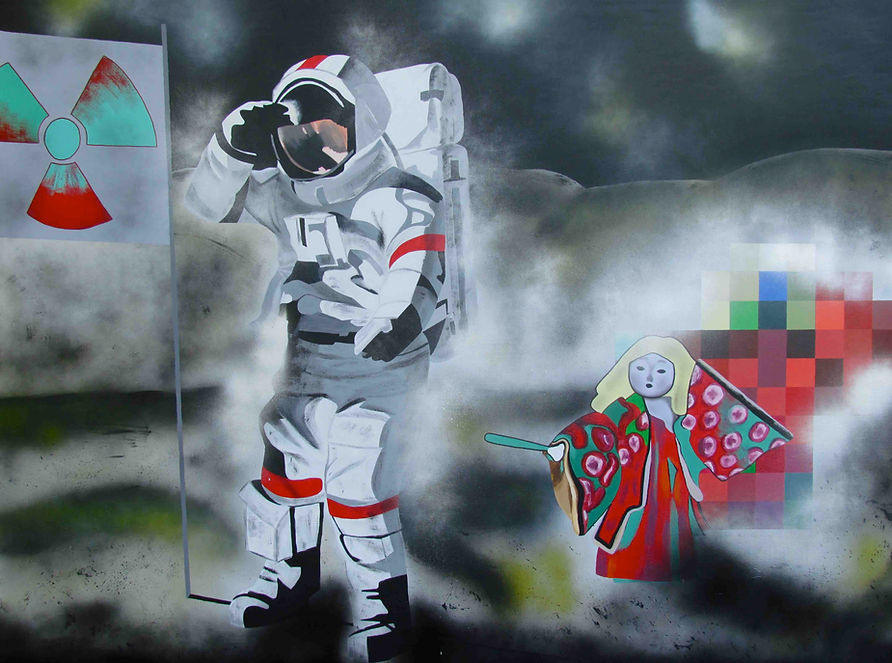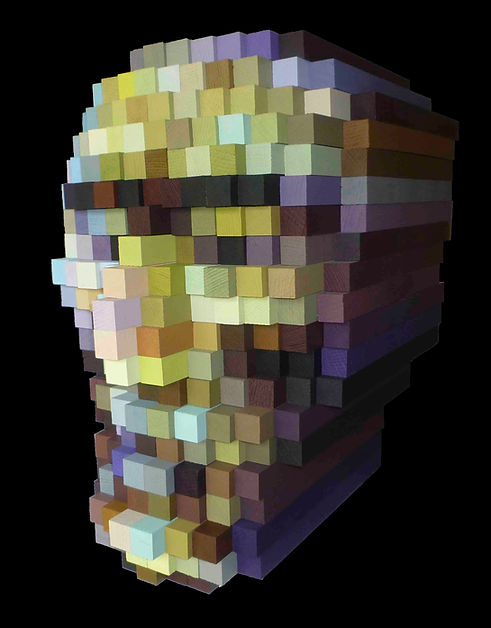
PAST TO THE FUTURE
Peindre le temps, est-ce peindre son temps ? La peinture que Caroline David propose au spectateur dans sa série Passé au futur (dans laquelle figure aussi la sculpture La tête au carré) est une peinture qui brasse, au sens physique du terme, un spectre temporel et géographique très large. Dans ses toiles, les monarques du XVIIe siècle cohabitent avec les artistes-rois du XXIe, la cour de Versailles (telle que le cinéma contemporain a pu la filmer) avec le luxe le plus tendance de Hong Kong (lui-même produit de l’exportation occidentale). Ces influences variées, mêlées, métissées, donnent à cette nouvelle série des airs de petit atlas imaginaire dans lequel le spectateur serait invité à une promenade dans le temps et l’espace. Au sein d’une culture devenue globale, les univers les plus hétéroclites se rencontreraient, sur le mode d’un contraste volontiers ludique, d’un dialogue à la liberté insolente, dont témoignent certains des titres choisis par l’artiste.

Inception - Acrylique et aérosol sur toile - 160 X 120 cm

Transparition - Acrylique et aérosol sur toile - 160 X 120 cm

Memories of a Geisha - Acrylic and spray on canvas - 63' X 47'

Marie-Antoinette to the Duchess of Polignac : "I really love this bag!" - Acrylic on canvas - 63' X 47'

Louis XIV to Takashi Murakami : "Don't you think the big pink rabbit would be better in the mirrors gallery"
Acrylic on canvas - 63' X 47'

Fukushima planet - Acrylic and spray on canvas - 63' X 47'

The squared head - Wooden sculpture - Acrylic on wood
Width 13' X height 20,5' X depth 20' - 84 lb / 38 kg

Shaolin fighter - Acrylic and spray on canvas - 63' X 47'
But beneath the colorful and often laughing surface of the paintings, behind the humor born of the incongruity of the confrontations and the apparent clarity of the line, one feels undoubtedly a certain concern.
Relay of the spectator within the painting, a geisha lost in the Tokyo of neon lights and an Indian lost in this urban utopia that is Brasilia, cast their gaze, lowered, stolen, on urban landscapes that have become unrecognizable or even unreadable. The question they seem to ask, perhaps to the viewer, is that which innervates all of the canvases in the series: what place for traditions - what place for them - in the contemporary world? Question that the composition of the paintings comes to redouble: relegated to the margin of the frame, these enigmatic figures, imbued with a rain of pixels, threaten to fade at any time.
By bringing together seemingly incompatible universes, Caroline David also puts them in tension, making possible surprising reversals of the situation: the canvas becomes a playground on which it is sometimes the outsider who takes revenge. How sad and dull, these supermarket aisles, in comparison to these two Dinka peasants who, torn from the alleys of their farms, failed! Through the artifice of composition and the play of colors, it is suddenly the familiar universe which is seen spectralized by the presence of an unknown world with the power of fascination intact. The same is true for this Shaolin monk, whose dazzling blade crosses time as much as the canvas, and seems to condemn the train sketched in the background, vague digital appearance, to disappear. Thus Caroline David's painting, rather than a simplistic denunciation of cultural Darwinism in the contemporary world, presents itself as a space for renegotiation, for rebalancing intercultural relations, in which traditions that are threatened or even disappeared, because they have passed, would find a new right of citizenship.
However, and this is also what makes the richness of her work, the question that Caroline David asks about the traditions that she stages in her paintings also applies, not without a certain irony, to her own painting . "What place for traditions in contemporary global culture? Ask the canvases. And the viewer responds: "what place for painting in an image culture dominated by photography, film, and digital image? Among the traditional gestures that Caroline David questions and stages, there is one that is invisible because it is omnipresent: painting itself.
Painting is indeed one of those traditions threatened by technological evolution: as Roland Barthes points out in La Chambre claire, the advent of photography brought painting into the age of obsession, which the recent development of digital technology has only exacerbated: “Photography has been, is still tormented by the ghost of Painting. Caroline David's work attests to the fact that the equation can be reversed: if painting competes with other images, it can also beat them at their own game by assimilating their techniques.
Not only do the canvases of Past to the future refuse abstraction, in which we have been able to see a response from painting to competition from photography in imitation of reality, but above all, they bring photography back to the canvas, transformed basis pictorial work, but also newer technologies and arts. With photography, cinema and digital technologies (already present in his previous series, Avatar) are thus reintegrated into the gesture of painting.
In an approach that pursues that of pop-art, the artist, while embracing modernity, refuses to sacrifice painting to her.
In addition, modern technologies not only provide it with elements of pictorial language (pixelation and chromatic work from digital arts, overexposure, solarization effects and negatives from photography), but, more crucially, matter even of his paintings, thanks to the unprecedented access that modern technologies give to the image.
It is thus under the sign of ambiguity that Caroline David paints modernity. By painting time, the passage of time, the time that separates cultures but also that, sometimes surprisingly, unites the most diverse traditions, she also paints, if not her time, at least with her time: a time in which globalization, while threatening to eradicate traditional cultures, also gives us the opportunity to start a renewed dialogue with them.
Vanasay Khamphommala
Playwright and performer
Artiste peintre contemporain. Artiste peintre émergent. Artiste femme connue. Artiste peintre connu. Artiste connu. Artiste femme contemporaine émergente. Artiste contemporain connu. Artiste contemporaine connue. Artiste peintre célèbre. Artiste femme célèbre.